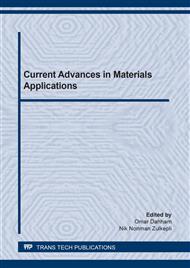[1]
F. Poulon, H. Mehidine, M. Juchaux, P. Varlet, B. Devaux, J. Pallud, D. Abi Haidar, Optical properties, spectral, and lifetime measurements of central nervous system tumors in humans, Sci. Rep. 7 (2017) 1–8.
DOI: 10.1038/s41598-017-14381-1
Google Scholar
[2]
M.M. Jawad, S.T.A. Qader, A.A. Zaidan, B.B. Zaidan, A.W. Naji, I.T.A. Qader, An overview of laser principle, laser-tissue interaction mechanisms and laser safety precautions for medical laser users, Int. J. Pharmacol. 7 (2011) 149–160.
DOI: 10.3923/ijp.2011.149.160
Google Scholar
[3]
W. Sheng, S. He, W.J. Seare, A. Almutairi, Review of the progress toward achieving heat confinement—the holy grail of photothermal therapy, J. Biomed. Opt. 22 (2017) 080901.
DOI: 10.1117/1.jbo.22.8.080901
Google Scholar
[4]
T. Kujawska, W. Secomski, E. Kruglenko, K. Krawczyk, A. Nowicki, Determination of tissue thermal conductivity by measuring and modeling temperature rise induced in tissue by pulsed focused ultrasound, PLoS One. 9 (2014).
DOI: 10.1371/journal.pone.0094929
Google Scholar
[5]
O.I. Craciunescu, L.E. Howle, S.T. Clegg, Experimental evaluation of the thermal properties of two tissue equivalent phantom materials, Int. J. Hyperth. 15 (1999) 509–518.
DOI: 10.1080/026567399285503
Google Scholar
[6]
C.H. Yang, W. Li, R.K. Chen, Characterization and modeling of tissue thermal conductivity during an electrosurgical joining process, IEEE Trans. Biomed. Eng. 65 (2018) 365–370.
DOI: 10.1109/tbme.2017.2770095
Google Scholar
[7]
M. Dewhirst, B.L. Viglianti, M. Lora-Michiels, P.J. Hoopes, M.A. Hanson, Thermal dose requirement for tissue effect: experimental and clinical findings, Therm. Treat. Tissue Energy Deliv. Assess. II. 4954 (2003) 37.
DOI: 10.1117/12.476637
Google Scholar
[8]
A. Feldmann, P. Wili, G. Maquer, P. Zysset, The thermal conductivity of cortical and cancellous bone, Eur. Cells Mater. 35 (2018) 25–33.
DOI: 10.22203/ecm.v035a03
Google Scholar
[9]
A. Anand, P.J. Kaczkowski, Noninvasive Measurement of Local Thermal Diffusivity Using Backscattered Ultrasound and Focused Ultrasound Heating, Ultrasound Med. Biol. 34 (2008) 1449–1464.
DOI: 10.1016/j.ultrasmedbio.2008.02.004
Google Scholar
[10]
H. Zhu, Y. Fang, Q. Miao, X. Qi, D. Ding, P. Chen, K. Pu, Regulating Near-Infrared Photodynamic Properties of Semiconducting Polymer Nanotheranostics for Optimized Cancer Therapy, ACS Nano. 11 (2017) 8998–9009.
DOI: 10.1021/acsnano.7b03507
Google Scholar
[11]
W.T. Rahman, D.J. Wale, B.L. Viglianti, D.M. Townsend, M.S. Manganaro, M.D. Gross, K.K. Wong, D. Rubello, The impact of infection and inflammation in oncologic 18F-FDG PET/CT imaging, Biomed. Pharmacother. 117 (2019) 109168.
DOI: 10.1016/j.biopha.2019.109168
Google Scholar
[12]
P. Gopalakrishnan, Influence of Laser Parameters on Selective Retinal, Thesis. (2005).
Google Scholar
[13]
B. Chen, Experimental and Modeling Study of Thermal Response of Skin and Cornea to Infrared Wavelengths Laser Irradiation, (2007).
Google Scholar
[14]
R.F. Reinoso, B.A. Telfer, M. Rowland, Tissue water content in rats measured by desiccation, J. Pharmacol. Toxicol. Methods. 38 (1997) 87–92.
DOI: 10.1016/s1056-8719(97)00053-1
Google Scholar
[15]
J.T. Walsh, T.F. Deutsch, J.T. Walsh, Pulsed CO2 Laser Ablation of Tissue: Effect of Mechanical Properties, IEEE Trans. Biomed. Eng. 36 (1989) 1195–1201.
DOI: 10.1109/10.42114
Google Scholar
[16]
K.S. Shibib, M.A. Munshid, K.A. Hubiter, Analytical model of transient thermal effect on convectional cooled end-pumped laser rod, Pramana - J. Phys. 81 (2013) 603–615.
DOI: 10.1007/s12043-013-0600-x
Google Scholar
[17]
M. Hafid, M. Lacroix, Prediction of the Thermal Parameters of a High-Temperature Metallurgical Reactor Using Inverse Heat Transfer, Int. J. Mech. Mechatronics Eng. 10 (2016) 1042–1048.
Google Scholar
[18]
M. Hafid, M. Lacroix, An Inverse Heat Transfer Algorithm for Predicting the Thermal Properties of Tumors during Cryosurgery, Int. J. Medical, Heal. Biomed. Bioeng. Pharm. Eng. 11 (2017) 298–306.
Google Scholar
[19]
P.D. Sanz, M.D. Alonso, R.H. Mascheroni, Thermophysical Properties of Meat Products: General Bibliography and Experimental Values., Trans. Am. Soc. Agric. Eng. 30 (1987) 283–289, 296.
DOI: 10.13031/2013.30441
Google Scholar
[20]
D. Ulrich, B. Van Rietbergen, H. Weinans, P. Rüegsegger, Finite element analysis of trabecular bone structure: A comparison of image-based meshing techniques, J. Biomech. 31 (1998) 1187–1192.
DOI: 10.1016/s0021-9290(98)00118-3
Google Scholar


